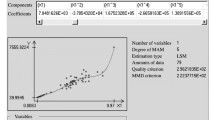A program for identifying the cosmological distance scale for different models of the red shift in the spectra of extragalactic sources from the observed red shifts and stellar magnitudes, combined with the database on supernovae, radio galaxies and quasars, is developed. The Friedmann–Mattig and generalized interpolation models in combination with models of the intrinsic red shift of the sources are taken as the main parameters.
Similar content being viewed by others
References
M. Humason, N. Mayall, and A. Sandage, “Red shift and magnitudes of extragalactic nebulae,” Astronom. J., 61, 97 (1956).
W. K. Freedman et al., “Final results from the Hubble space telescope key project to measure the Hubble constant,” Astrophys. J., 553, 47 (2001).
A. G. Riess et al., “A redetermination of the Hubble constant with the Hubble space telescope from a differential distance ladder,” http://arXiv:0905.0695v1[astro-ph.CO], accessed Dec. 15, 2012.
S. Perlmutter et al., “Measurements of Ω and Λ from 42 high-red shift supernovae,” Astrophys. J., 517, 565–586 (1999).
G. Burbidge and M. Burbidge, Quasi-Stellar Objects, W. H. Freeman, San Francisco (1967).
S. F. Levin, “A cosmological distance scale based on a red shift interpolation model,” Izmer. Tekhn., No. 6, 12–14 (2012); Measur. Techn., 55, No. 6, 609–612 (2012).
Yu. S. Vladimirov, A. N. Klenitskii, and V. G. Krechet, “The problem of interpreting the cosmological red shift,” Yarosl. Pedagog. Vestnik, No. 2, 53–62 (2010).
S. F. Levin, “Statistical methods of solving cosmological and gravitational measurement problems,” in: Physics of Fundamental Interactions: Proc. Int. Conf. on Nuclear Physics, OFN Ross. Akad. Nauk, Moscow (2012).
K. Lang, Astrophysical Formulae, Springer, NY (1999).
J. Guy et al., “The supernova legacy survey 3-year sample: Type Ia supernovae photometric distances and cosmological constraints,” Astron. Astrophys., 523, A7 (2010).
Sloan Digital Sky Survey Quasars, http://cas/sdss/org/dr7/en/proj/advanced/quasars/query.asp, accessed Jan. 15, 2013.
Author information
Authors and Affiliations
Corresponding author
Additional information
Translated from Metrologiya, No. 1, pp. 3–7, January, 2013.
Rights and permissions
About this article
Cite this article
Klenitskii, A.N. A cosmological distance scale program. Meas Tech 56, 223–225 (2013). https://doi.org/10.1007/s11018-013-0183-4
Received:
Published:
Issue Date:
DOI: https://doi.org/10.1007/s11018-013-0183-4




